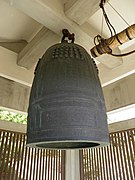Eisan-ji
The Eisan-ji ( Japanese 栄 山寺 ) is a temple of the Shingon direction of Buddhism on the outskirts of the city of Gojō ( Nara Prefecture ), directly above the Yoshino River.
history
In the year 719 Fujiwara no Muchimaro ( 藤原 武 智 麻 呂 ; 680-737) is said to have built the temple under the name Sakiyama-no-dera ( 前 山寺 ). Since the temple flourished in the Heian period (= 栄 ), it is said to have received its current Sino-Japanese name, namely Eisan-ji, according to tradition. There are no exact documents about the founding of the temple, but since the southern Fujiwara ( 藤原 南 家 ) owned large estates there from the Nara period , the tradition is not completely absurd. At the time of the split in the imperial court , three emperors stayed here, so that the remains of the residences at the temple ( 行宮 跡 ; Angū-seki ) are identified as traces of national history.
The attachment
The main hall ( 本 堂 , Hondō ) is also called "Hall of Yakushi". It dates from the late Muromachi period . The main cult figure, the seated Yakushi Buddha , is a good example of a sculpture of that time. The Buddha is only visible to the general public for ten days in spring and autumn. In addition to other figures, there is also the group of the twelve heavenly generals . The stone lantern in front of the hall dates from 1284 and is registered as an important cultural asset .
The more important building is the octagonal hall ( 八角 堂 , Hakkaku-dō ). It was built by Fujiwara no Muchimaros son Nakamaro ( 仲 麻 呂 ; 706-764) in the Tempyō-Hōji time (757-765) and is declared a national treasure. It has double doors and lattice windows on four sides. The roof, which is covered with tiles, is crowned by a treasure pearl ( 宝珠 , Hōju ) made of stone. The inside is painted with saints, angels and plants. The originally strong colors have faded, photos in their old condition can be seen in the main hall.
The temple bell ( 梵 鐘 , Bonshō ) is also a national treasure . As the inscription says, it dates from the year 917. Sugawara no Michizane and the court official and scholar Ono no Michikaze ( 小野 道 風 ; 894–967) appear in the inscription.
Next to the Dainichi Hall ( 大 日 堂 , -dō ) built in the Muromachi period, there is a stone-built seven- tier pagoda ( 七 重 塔 , Nanajū-no-tō ), which is registered as an important cultural asset.
photos
Remarks
- ↑ His grave is on the hill above the temple.
literature
- Nara-ken kotogakko-kyoka token kenkyu-kyokai rekishi bukai (Ed.): Eisan-ji . In: Nara-ken no rekishi sampo (ge). '' Yamakawa Shuppan, 2010. ISBN 978-4-634-24829-8 . P. 208.
Web links
Coordinates: 34 ° 21 '21.3 " N , 135 ° 43' 14.9" E




